» posted on Friday, April 5th, 2013 by Linda Lou Burton
Liquid Corn
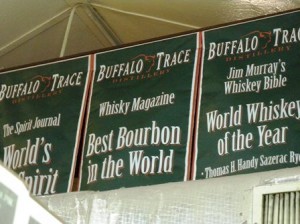 Linda Burton posting from Frankfort, Kentucky – “It was used for medicinal purposes,” Fred answered. “It’s been said there were more sick people in Kentucky during prohibition years than at any other period of time.” This brought a laugh from the group; twenty people gathered for the beginning of a tour of Buffalo Trace, a Frankfort bourbon distillery that’s been in business over 200 years. Fred had told us it was a continuous operation “even during Prohibition,” so of course I asked how they got permission from the federal government to stay open. “The doctor wrote out a prescription and you dropped by to pick up your pint,” he continued. Ah, so people were after its “curative” properties! Bourbon whiskey is, by definition, mostly corn, Fred
Linda Burton posting from Frankfort, Kentucky – “It was used for medicinal purposes,” Fred answered. “It’s been said there were more sick people in Kentucky during prohibition years than at any other period of time.” This brought a laugh from the group; twenty people gathered for the beginning of a tour of Buffalo Trace, a Frankfort bourbon distillery that’s been in business over 200 years. Fred had told us it was a continuous operation “even during Prohibition,” so of course I asked how they got permission from the federal government to stay open. “The doctor wrote out a prescription and you dropped by to pick up your pint,” he continued. Ah, so people were after its “curative” properties! Bourbon whiskey is, by definition, mostly corn, Fred 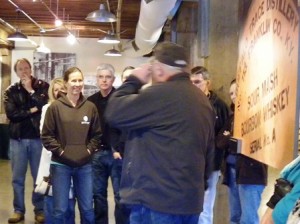 continued, and I visualized the rows of corn my Granddad planted; his cornfield stretched all the way from the house to the railroad track. “Don’t put the water on to boil till you head out the door to pick the corn,” Granddad would say, when corn-on-the-cob season finally arrived; he believed it had to be that fresh to be good. So I grew up with corn, the juiciest, sweetest, most delicious vegetable God ever created. And easy to grow. That’s why American pioneers (British-French-German-Irish-Scottish-Welch) planted it as they moved westward across the Alleghenies after the Revolutionary War, into
continued, and I visualized the rows of corn my Granddad planted; his cornfield stretched all the way from the house to the railroad track. “Don’t put the water on to boil till you head out the door to pick the corn,” Granddad would say, when corn-on-the-cob season finally arrived; he believed it had to be that fresh to be good. So I grew up with corn, the juiciest, sweetest, most delicious vegetable God ever created. And easy to grow. That’s why American pioneers (British-French-German-Irish-Scottish-Welch) planted it as they moved westward across the Alleghenies after the Revolutionary War, into 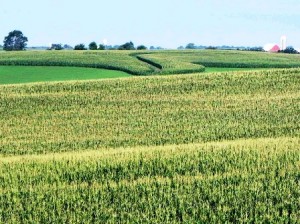 the vast open farmlands that eventually became Kentucky. The soil was rich, the sun was warm, and the corn grew. Now think about it – how much corn can you eat, or feed to your animals, and then, how much corn can you sell? Roads were bad back then; shipping was costly, and timing was a factor. Turn it into a liquid; that was the profitable answer. And so bourbon whiskey was born.
the vast open farmlands that eventually became Kentucky. The soil was rich, the sun was warm, and the corn grew. Now think about it – how much corn can you eat, or feed to your animals, and then, how much corn can you sell? Roads were bad back then; shipping was costly, and timing was a factor. Turn it into a liquid; that was the profitable answer. And so bourbon whiskey was born.
How did the name “bourbon” come to be associated with the corn whiskey from Kentucky? A logical bit of fate, really; go back in time to October, 1785. That’s when Bourbon County was formed; named after the French House of Bourbon, in gratitude for the assistance Louis XVI gave during the American Revolutionary War. This land was originally part of the French province of Louisiana; then it became part of Virginia. When the Commonwealth of Kentucky was created from Virginia in 1792, Bourbon County then became a large county in Kentucky (that territory is now divided into 34 Kentucky counties).
But back to the “bourbon whiskey” name. The farmers shipped their whiskey in oak barrels with their location “Bourbon County” stamped on the side; during the long trip down the Ohio and Mississippi rivers to New Orleans, the whiskey aged and took on a distinct mellow flavor 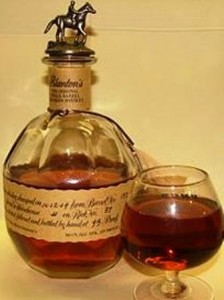 and amber color. It was a sensation in Europe; it reminded the French of a good cognac. It was known as “bourbon whiskey” from there on; a true American creation, Kentucky made.
and amber color. It was a sensation in Europe; it reminded the French of a good cognac. It was known as “bourbon whiskey” from there on; a true American creation, Kentucky made.
Today thirteen large distilleries produce over 99% of the whiskey made in the United States; Buffalo Trace, where I’m standing today, is one of them. Bourbon whiskey can be made anywhere, but the unique ingredient Kentucky offers is pure limestone-filtered water. Legally, the Federal Standards of Identity for Distilled Spirits (27 CFR 5) require that bourbon made for US consumption must be:
- made from a grain mixture that is at least 51% corn
- aged in new, charred-oak barrels
- distilled to no more than 160 (US) proof (80% alcohol by volume)
- bottled at 80 proof or more (40% alcohol by volume)
Bourbon has no minimum specified duration for its aging period, but bourbon that has an age stated on its label must be labeled with the age of the youngest whiskey in the bottle.
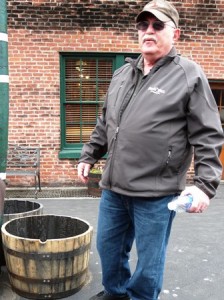 With age comes distinction (ah yes, I’m thinking, as I stand there on my birthday); Fred led us outside and explained how the oak barrels are burned on the inside to a precise degree of “char;’ then he led us into a building where the ultimate Buffalo Trace brands are fancied up for packing and shipping. A wall of bourbon fumes hit as we stepped inside and filed down the assembly line; starting at the end, where a man in an orange Buffalo Trace tshirt was placing three beautifully etched bottles into a box; it was the Eagle Rare brand, aged 10 years. Just before that another man sat in front of a window, earplugs in; he carefully hand-wrapped a label around the
With age comes distinction (ah yes, I’m thinking, as I stand there on my birthday); Fred led us outside and explained how the oak barrels are burned on the inside to a precise degree of “char;’ then he led us into a building where the ultimate Buffalo Trace brands are fancied up for packing and shipping. A wall of bourbon fumes hit as we stepped inside and filed down the assembly line; starting at the end, where a man in an orange Buffalo Trace tshirt was placing three beautifully etched bottles into a box; it was the Eagle Rare brand, aged 10 years. Just before that another man sat in front of a window, earplugs in; he carefully hand-wrapped a label around the 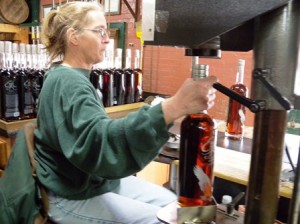 neck of each bottle that came his way; dreaming, I’d bet, as he performed his repetitive task. At the beginning of the line a woman sat beside a rack; the bottles there had just been filled and were waiting to be capped. She had two operations to perform: first she set a bottle on one section of her machine where it placed a cap; then she moved the bottle to another section and the machine secured the cap, as well as the paper on the bottle’s neck.
neck of each bottle that came his way; dreaming, I’d bet, as he performed his repetitive task. At the beginning of the line a woman sat beside a rack; the bottles there had just been filled and were waiting to be capped. She had two operations to perform: first she set a bottle on one section of her machine where it placed a cap; then she moved the bottle to another section and the machine secured the cap, as well as the paper on the bottle’s neck.
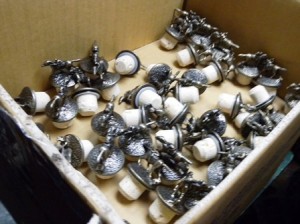 The next assembly line was working on the Blanton’s brand; a single-barrel bourbon. “Single barrel” means just what you’d think – the contents come from one particular aging barrel, not mixed with any other. This means each barrel is constantly monitored by the Master Distiller, hand poured into the bottles, and as we can see before us, hand capped. I passed a box of “stoppers” used for the Blanton’s brand; there are eight different designs, with letters of the alphabet molded in, and topped with a figure of a racehorse and jockey. When placed in order spelling BLANTON’S, the “horse and jockey” poses display eight different scenes of a horse race, from standing at the gate to winning at the finish line. I admit to being wowed at this careful attention to each bottle; the stoppers are sealed with wax as well; a paper sleeve is placed on each bottle’s neck before the wax is
The next assembly line was working on the Blanton’s brand; a single-barrel bourbon. “Single barrel” means just what you’d think – the contents come from one particular aging barrel, not mixed with any other. This means each barrel is constantly monitored by the Master Distiller, hand poured into the bottles, and as we can see before us, hand capped. I passed a box of “stoppers” used for the Blanton’s brand; there are eight different designs, with letters of the alphabet molded in, and topped with a figure of a racehorse and jockey. When placed in order spelling BLANTON’S, the “horse and jockey” poses display eight different scenes of a horse race, from standing at the gate to winning at the finish line. I admit to being wowed at this careful attention to each bottle; the stoppers are sealed with wax as well; a paper sleeve is placed on each bottle’s neck before the wax is 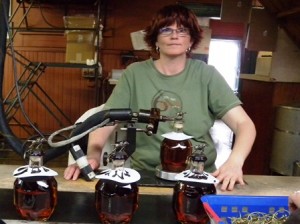 applied; once it has dried and all labels are secured, one person on the line has the task of ripping off the paper sleeve. I passed the trash can filled with the wax-splatted paper pieces and headed past the boxes now ready to be shipped. The slow pace of the bottling operation seemed to fit well with the slow pace of aging whiskey – take your time, and do it right. In this age where production speed is touted, this seemed a miracle of loving care.
applied; once it has dried and all labels are secured, one person on the line has the task of ripping off the paper sleeve. I passed the trash can filled with the wax-splatted paper pieces and headed past the boxes now ready to be shipped. The slow pace of the bottling operation seemed to fit well with the slow pace of aging whiskey – take your time, and do it right. In this age where production speed is touted, this seemed a miracle of loving care.
The tour ended back in the Visitors Center, where it began; we were offered a taste of the different brands; there was root beer for the kids. Buy a bottle or buy a case; the gift shop was filled with other goodies, such as tshirts, glassware, candles, and intriguing Kentucky souvenirs.
Bourbon tourism is skyrocketing; more than 2.5 million visitors from all over the USA and countries around the world have followed the famous Kentucky Bourbon Trail in the last five 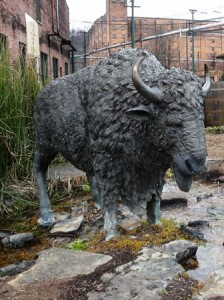 years. Within a few miles of Frankfort – towards Lexington and Louisville both –you’ll find Four Roses, Heaven Hill, Makers Mark, Jim Beam, Town Branch, Woodford Reserve, and Buffalo Trace, where we are learning about bourbon today. Within the past decade, Buffalo Trace has won more awards than any distillery in the world, including seven “Distillery of the Year” titles. It’s still family-owned and still located in Franklin County, Kentucky; it sprawls over 130 acres of rolling limestone hills near the Kentucky River, at 113 Great Buffalo Trace, Frankfort, Kentucky. Yes, the buffalo crossed here, many moons ago. And then, a new tradition began.
years. Within a few miles of Frankfort – towards Lexington and Louisville both –you’ll find Four Roses, Heaven Hill, Makers Mark, Jim Beam, Town Branch, Woodford Reserve, and Buffalo Trace, where we are learning about bourbon today. Within the past decade, Buffalo Trace has won more awards than any distillery in the world, including seven “Distillery of the Year” titles. It’s still family-owned and still located in Franklin County, Kentucky; it sprawls over 130 acres of rolling limestone hills near the Kentucky River, at 113 Great Buffalo Trace, Frankfort, Kentucky. Yes, the buffalo crossed here, many moons ago. And then, a new tradition began.
Our Bluegrass Tourbus exited past the historic marker sign; Debbie and Gordon and Joy and C W and I, the birthday gal, were wearing down after a long day. “Horses, Hooch & History” was the name of our tour; we all agreed we got our money’s worth. Tour Guide Bruce threw in one more fact as we rode along; “97% of all bourbon produced in the world is made right around here.” Liquid corn.
I found this quote from 1939 as I began to do my research for this post:
Taken sanely and in moderation whisky is beneficial, aids digestion, helps throw off colds, megrims and influenzas. Used improperly the effect is just as bad as stuffing on too many starchy foods, taking no exercise, or disliking our neighbor. – Charles H Baker Jr, The Gentleman’s Companion, 1939
About Bourbon http://www.tastings.com/spirits/american_whisky.html/
About the Kentucky Bourbon Trail http://kybourbontrail.com/history/
About Bluegrass Tours http://www.bluegrasstours.com/
